Clear Cloudy Pool Water in 24 Hours: Step-by-Step Clarifier Guide (and Fix It Fast)
If your pool water looks dull or milky, you’re not alone. Cloudy water is one of the most common pool issues—especially after a storm, a shock treatment, or heavy weekend use. The good news? You don’t need to drain your pool. The right pool clarifier for cloudy water can restore clarity fast by helping your filter capture tiny debris that normal filtration can’t grab.
At Benchmark Pool Supply, we stock professional-grade clarifiers, conditioners, and natural enzyme treatments that help you clear cloudy pool water fast and keep it that way. This guide explains how clarifiers work, which type to choose, and the exact steps to get sparkling results.
Why Your Pool Water Is Cloudy — and What It Really Means
Cloudiness signals that microscopic particles and organics are suspended in your water. These are often:
- Fine dust and pollen too small for standard filter media
- Body oils, sunscreen, and cosmetics left after swimming
- Dead algae and debris post-shock
- Dilution from rain and heavy bather load
- Unbalanced chemistry (pH or sanitizer out of range)
A pool clarifier binds those tiny particles together so your filter can remove them efficiently—restoring that crisp, blue sparkle.
Clarifier vs. Flocculant: Which Is Better for Cloudy Water?
| Treatment | Best For | How It Works | Filter Compatibility |
|---|---|---|---|
| Clarifier | Mild–moderate cloudiness; routine maintenance; after shock | Coagulates tiny particles so your filter traps them | Sand, DE, and cartridge filters |
| Flocculant | Severe cloudiness; “green to clean” turnaround | Drops debris to the floor for manual vacuuming to waste | Best with sand (avoid with cartridge; can clog) |
Rule of thumb: If you have a cartridge filter, choose a clarifier—not a flocculant.
Browse our Clarifiers Collection to find a formula that matches your pool and filter.
The Best Types of Pool Clarifiers for Homeowners
1) Polymer Clarifiers (Best Overall)
- Great for routine clarity and mild cloudiness
- Works with chlorine, salt, and bromine pools
- Compatible with sand, DE, and cartridge filters
2) Natural Clarifiers Safe for Swimmers and Pets
- Biodegradable (often chitosan-based) and non-toxic
- Ideal for family pools and eco-conscious owners
- Helps reduce scum lines and lotions
3) Enzyme Clarifiers for Heavily Used Pools
- Break down organic load (oils, cosmetics, sunscreen)
- Excellent for parties, summer peak, and frequent swimmers
- Work synergistically with your sanitizer for long-term clarity
Need more than a clarifier? Pair with stabilizers and conditioners from our Pool Chemicals collection. A customer favorite is Natural Chemistry Instant Conditioner to help stabilize chlorine levels.
How to Use a Pool Clarifier Properly (Step-by-Step)
-
Test and balance water first:
- pH: 7.2–7.6
- Free Chlorine: 1–3 ppm
- Total Alkalinity: 80–120 ppm
Stabilize chlorine if needed with Instant Conditioner. If pH is high, adjust with a measured dose of HASA Muriatic Acid.
- Dose the clarifier per label (commonly 1 oz per 5,000 gallons). Walk it around the perimeter with the pump on.
- Run the pump 24–48 hours continuously. This is crucial—no circulation, no clarity.
- Clean/backwash the filter after the water clears to remove captured debris.
Pro Tip: Wondering how to fix cloudy pool water after shock? Wait 24 hours post-shock, then add your clarifier and circulate overnight. This is one of the fastest ways to restore sparkle.
Choosing the Right Clarifier for Your Pool Type
| Pool Type | Best Clarifier Choice | Notes |
|---|---|---|
| Saltwater | Natural or enzyme clarifiers | Gentle, non-foaming; helps reduce film on cells |
| Chlorine | Polymer clarifier | Weekly/bi-weekly maintenance dose keeps water crisp |
| High-Bather Load | Enzyme clarifier | Breaks down oils and cosmetics from frequent use |
| Commercial | Concentrated polymer clarifier | Formulated for high turnover and heavy load |
Common Clarifier Mistakes to Avoid
- Overdosing: More isn’t better; too much can leave water dull or milky.
- Stopping circulation overnight: Clarifiers need continuous flow to work.
- Ignoring sanitizer levels: Clarifiers don’t kill algae—maintain chlorine.
- Stacking chemicals at once: Avoid adding clarifier at the same time as shock or algaecide. Space treatments by 24 hours.
Buy with Confidence from Benchmark Pool Supply
We proudly serve Fresno and Clovis with expert advice and the best pool clarifiers and conditioners on the market. Shop our most-used links:
- Best Clarifiers for Cloudy Pool Water
- Pool Chemicals & Conditioners
- Natural Chemistry Instant Conditioner
- HASA Muriatic Acid (31%)
Frequently Asked Questions
What is the best pool clarifier for cloudy water?
The best choice depends on your filter. For cartridge filters, use a polymer or enzyme-based clarifier. For sand/DE, polymer clarifiers are ideal for routine clarity.
How long does a pool clarifier take to work?
With balanced water and continuous circulation, most pools clear within 24–48 hours.
Can I use a clarifier after shocking my pool?
Yes—wait at least 24 hours after shocking. Then add the clarifier and run the pump non-stop to capture the dead contaminants.
What’s a natural pool clarifier that’s safe for swimmers?
Chitosan-based clarifiers are biodegradable and non-toxic, making them a great choice for family pools and eco-minded owners.
How often should I add clarifier?
Use a maintenance dose every 1–2 weeks during swim season, and after storms or heavy use to prevent recurring cloudiness.




